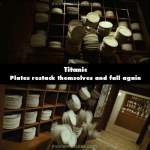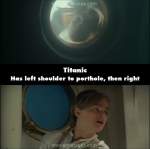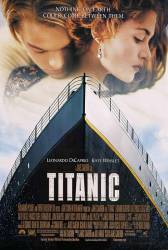
Continuity mistake: We see the plates sliding out of the holder and smashing as the ship starts to go vertical. Then 50 seconds later we see more plates falling from the same holder. However, the positions of the plates have changed and there are stacks of plates in sections that were empty. (02:30:10 - 02:31:00)
Continuity mistake: When the pastor is giving a sermon on the deck of the sinking Titanic, there are people grabbing his hands in one shot and not in the next. (02:29:45)
Audio problem: When the steward is getting Rose and Cal's life jackets from the closet he says about top coats and hats, However his mouth stops moving after the word coats. (01:44:00)
Continuity mistake: We see Mr Andrew walking through the 1st class cabins just after hitting the iceberg. He has 4 blueprint rolls under his arms. We then see him out on deck while discussing the situation with a few other men and the rolls have gone. As he gets to the office with Captain Smith he has the rolls again. (01:39:20)
Visible crew/equipment: When we see Jack moving the sofa for Rose to lie on, look in the window behind him to the right. You can see the cameraman's shadow moving with the camera. (01:21:25)
Continuity mistake: When we see Jack and Fabrizo at the front of the ship, in one shot we see the wind blowing Jack's hair and jacket. In the next shot it's not. (00:29:50)

Continuity mistake: When Jack looks through the porthole (which is full submerged underwater) while cuffed, he looks over his left shoulder which is facing the hull of the ship. He then turns his head which cuts to him inside the room, his left shoulder is now facing away from the hull of the ship, towards the door. The shot of him looking through the porthole is possibly a reversed shot.
Factual error: When Rose's mother is having tea, all the women are wearing gloves as they have tea. This would never have happened as Edwardian ladies always removed their gloves and placed them in their laps under their napkins when they sat at a table, before eating or drinking anything so as not to soil them.
Other mistake: In the scene where Rose is sitting in front of her vanity mirror after Jack saves her life, Cal bestows upon her the 16-carat Heart of the Ocean necklace. He drapes the necklace around her neck but never actually fastens it (the camera's on him the whole time), yet it stays in place even as Rose touches the diamond and runs her fingers across the chain. A 16-carat diamond would slide right off someone's neck if it were not properly fastened.
Suggested correction: It's actually 56 carats, and if you watch it again, he keeps his hand on the back of her neck over the clasp. He is the one keeping it in place.





